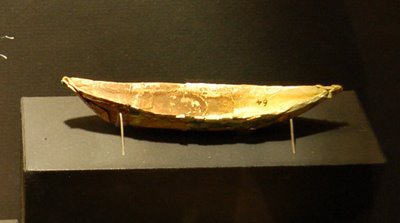
From a burial mound in Thy in North Jutland is an unusual find: a clay vessel with 100 little gold boats. Every boat is built by leaves of gold foil around cross ribs of bronze bands. The boats are between 10 -17 cm long, and they have by form and construction a strong resemblance to the stretched dugouts , which are known from Slusegård. Their age is uncertain - they are dated to as well late Bronze Age as to Iron Age. From the form and from the simple decoration - and regarding the riches of gold i late Roman period and early Germanic Iron Age - then the fourth or fifth century A.D seems to be the most probable dating, and then they are a fine illustration of the Iron Age's little dugouts. 95 boats are at the National Museum, and five have been returned to Thisted Museum in Thy.

The story behind the find:
A little more than 100 years ago the small village Nors in Thy became wellknown throughtout the country, caused by the find of 100 gold boats. It started on Tuesday 12. May 1885, when the farmers Hans Jensen from Thisted Mark and Jens Lukassen from Brund were digging grovel at Thorshøj. (burial mound). Close east of the hill they had opened a new hole in the slope, when the mattock hit the bottom of a large clay vessel just below the surface, and the contents of the vessel came rattling down over the surprised finders. Lots of small boats in gold sheet sailed down the slope. Both men knew at once that this was really something special. Each piece was carefully gathered and put into their lunch box (old-fashioned wooden box, named a tejne) - and with this they went to the nearby city Thisted and presented their find to the local authorities, which sent the unusual find to Oldnordisk Museum in Copenhagen (which later became the National Museum) with a description of the happening and a request that the finders would be paid the value of the find - and if they kept the lunch box in Copenhagen the farmers also wanted to have the value of this, ( 80 øre = 4/5 of a krone). The finders got the gold value 480 Danish kroner and a reward of 20 kroner plus the 80 øre for the lunch box.
Only 14 days later the same two men found in the same place a large heavy gold ring with a weight of 400 gram. This was also sent to Oldnordisk Museum, and the finders got over 900 kroner. At that time an average hourly wage was 20 øre (1/5 krone). So first 480 kroner and then over 900 kroner. A lot of money - and although they had to share, the money meant a turning point in their life.
To deliver the gold boats as Danefæ belongs to an old practice. The rules about Danefæ are some of the earliest legal provisions in Europe, which are still used - they go back to Jyske Lov of 1241. (Valdemar II Sejr). Back then as today it is the basis that find of gold and silver (with no owner) belonged to the king (today to the State) - should be handed over for a remuneration , which is the metal value of the find and a reward , dependent on the rarity of the find and the finder's taken care of the things. Today the Danefæ-rules are extended - i.e. rare ancient things in other material than gold and silver might be declared Danefæ.
Source: Gyldendals Danmarkshistorie, Danernes Land, 200 F.KR til 700 ; Bredal Geocaching.

photo Thisted Museum 2006: grethe bachmann
4 comments:
Denmark is filled with the most amazing events. I asked my hub to come look at these boats. We didn't visit the National Museum our last visit to Copenhagen and missed a real treasure. It's a fantastic story of how the boats were found. And how they were turned over to the state is fabulous. The fact that Danes take such pride in their history is inspirational. Thank you for a wonderful bit of Danish history.
Thanks Kittie! I have not seen the boats on the National Museum, I only saw the five boats at the museum in Thisted, but I think they are absolutely beautiful. Imagine the village "goldsmith" sitting there and creating those pretty little golden boats so long time ago.
Cheers
Thyra
How beautiful, and what an amazing story of how these were found. Does anyone know why they were made? It seems curious that a hundred of them would be inside a clay vessel.
As far as I know they are considered as a sacrifice to the gods. Where they were found was probably once a lake, and people sacrificed weapons and valuable possessions to the gods in the lake during solemn heathen ceremonies . They even made valuable and magnificent swords, which were never used, but sacrificed to the gods. It meant life and death to them to be friends with the gods.So these boats were probably made for the gods. For good luck in sailing? At that time there were large lakes and the water streams were navigable far into the country.
Post a Comment